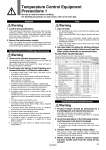
m-03-3c-seihin_enЃ@Ѓ@Ѓ@62 / 77
10•bЊг‚ЙBOOK‚МѓyЃ[ѓW‚Й€Ъ“®‚µ‚Ь‚·
Temperature Control Equipment Precautions 1 Be sure to read this before handling. For detailed precautions on each series, refer to the main text. Selection Warning 1. Confirm the specifications. Fully understand the applications, environment, fluids and other operating conditions. Use this product within the specified range shown in this catalog. Using outside the specified range can cause injury, damage, or malfunction. When in doubt, please contact SMC beforehand. 2. Secure the performance margin. When you consider the productЃfs cooling/heating performance or flow characteristics, allowance must be made because there are heat loss from the piping, etc. or pressure drop. Operating Environment/Storage Environment Warning 1. Observe the ambient temperature range. The operating ambient temperature range must be within the specification range shown in this catalog. Use caution because using beyond the range will lead to damage, breakage or malfunction. 2. Avoid using and storing in the following environment because it will lead to malfunction. 1. In locations where water, water steam, salt water, and oil may splash on the product. 2. In locations where a large amount of particles are airborne. 3. In locations with an atmosphere of corrosive or explosive gases, solvents, or chemicals. (This product is not explosion proof.) 4. In locations which receive direct sunlight or radiated heat. (Protect from direct sunshine to avoid the resin from deteriorating by ultraviolet rays or increasing the temperature.) 5. In locations where temperature substantially changes. 6. In locations where there is a heat source nearby and the ventilation is poor. (Insulate the heat source or ventilate well to avoid damages caused by the heat or temperature increase, such as softening.) 7. In locations where condensation occurs. 8. In locations where strong magnetic noise occurs. (In locations where strong electric fields, strong magnetic fields and surge voltage occur.) 9. In locations where static electricity occurs, or conditions which make the product discharge static electricity. 10. In locations where high frequency occurs. 11. In locations where damage is likely to occur due to lightning. 12. In locations where impacts or vibrations occur. 13. In conditions where a massive force strong enough to deform the product is applied or a weight from a heavy object is applied. 14. In locations more than 1000 m in altitude (except storage, transportation) Fluid Warning 1. Type of fluids 1. The operating fluids must be used within the specified range shown in this catalog. Please consult with SMC when using the product with other fluids. 2. Depending on the combination, foreign matter, chemical leakage and catalysts may change the piping material and operating fluid qualities. 3. When solid foreign objects may be mixed with a fluid, install a filter to remove them. Transportation/Transfer/Movement Warning 1. Product transfer should be performed by a knowledgeable and experienced person. Especially, transferring a heavy object is dangerous. Use adequate caution to prevent falling down or dropping accidents from occurring. 2. Avoid transportation in the following environment because it will lead to breakage. 1. In conditions where strong shock and vibrations occur. 2. In operating and storage environments other than those specified. 3. Caution when transferring a heavy object This product is heavy. Use adequate caution to avoid injury when picking up and setting down the product, and falling and dropping accidents should be avoided. 4. Before moving this product, remove operating fluid, facility water from the inside of this product. 2. Use clear water (including for diluting ethylene glycol aqueous solution) which must meet the water quality standards as mentioned below. The Japan Refrigeration and Air Conditioning Industry Association JRA GL-02-1994 ЃgCooling water system . Circulation type . Circulating waterЃh Facility Water Quality Standard Standard item Reference item Item pH (at 25Ѓ‹C) Electric conductivity (25Ѓ‹C) Chloride ion (Cl.) Sulfuric acid ion (SO4 2.) Acid consumption amount (at pH4.8) Total hardness Calcium hardness (CaCO3) Ionic state silica (SiO2) Iron (Fe) Copper (Cu) Sulfide ion (S2 .) Ammonium ion (NH4 +) Residual chlorine (Cl) Free carbon (CO2) Unit . [ѓКS/cm] [mg/L] [mg/L] [mg/L] [mg/L] [mg/L] [mg/L] [mg/L] [mg/L] [mg/L] [mg/L] [mg/L] [mg/L] Standard value Influence Corrosion Scale generation 6.0 to 8.0 100. to 300. 50 or less 50 or less 50 or less 70 or less 50 or less 30 or less 0.3 or less 0.1 or less Should not be detected. 0.1 or less 0.3 or less 4.0 or less р· р· р· р· р· р· р· р· р· р· р· р· р· р· р· р· р· . In the case of [Mѓ¶рЏcm], it will be 0.003 to 0.01. рЏ рІ : Factors that have an effect on corrosion or scale generation. рЏ Even if the water quality standards are met, complete prevention of corrosion is not guaranteed. 57